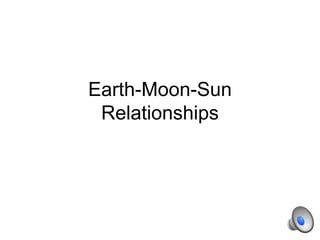
HPU NCS2200 Earth moon-sun relationships Lecture
- 2. Earth Movement Through Space • Revolution – movement around the sun – 1 revolution takes ~365 days = 1 year • Rotation – movement on its axis – 1 rotation takes ~ 24 hours = 1 day • Precession – the change in the earth’s tilt on its axis – Changes the angle of earth’s tilt approximately every 20,000 years
- 5. Barycenter • Barycenter –the point between two objects where they balance each other – The center of the mass between the Earth and the Moon
- 6. Earth’s Shape • Earth is not perfectly round but bulges due to the gravitational and rotational effects of the Moon and the Sun on the Earth • Gravity of an object pulls in toward its center. • Rotational forces act to push out. • These two forces pull at the Earth in different proportions causing the less than spherical shape.
- 7. Motions of Earth and the Moon • Full moon – rises at about sunset – Each night it rises 53 minutes later because it moves ahead of the earth by 12o each night – The moon does not emit light, it reflects sunlight – The Moon’s plane of orbit is tilted 5.2o above the earth’s equatorial plane. • Thus the Earth’s shadow doesn’t always cover it up
- 8. Earth-moon Geometry Notice the angle of the moon’s revolutionary plane with respect to the earth’s Revolutionary plane. This places the moon above or below the earth’s path Thus placing the moon only RARELY in the direct shadow of the Earth.
- 9. Motions of the Earth and the Moon • Normally we see the PHASES of the moon as it revolves around the earth. • Revolves around Earth in 29.5 days • The Phases of the Moon – New moon – when the moon is dark – Crescent moon – four days later – Gibbous moon – bright moon 10 days after – Full moon – 14-15 days after the new moon – Waning moon – as it shrinks toward the next new moon
- 11. Lunar Eclipse • Since I am NOT the expert here I am going to let the expert speak for himself. • Click the link to go to Mr. Eclipse’s website and read all about Lunar Eclipse. Then come back here and we’ll see what we can summarize about this phenomenon • http://www.mreclipse.com/Special/SEprim er.html
- 12. Summary of Lunar Eclipse • Pretty Cool! • So basically the Lunar eclipse occurs when the moon passes through the preumbra or umbra shadow of the earth – but this only happens when the moon is in the same plane as the earth! The activty to build your sun-earth-moon Model will help with this understanding!
- 13. Moon-Earth Forces • Tides are caused by the gravitational attraction of the Moon and Sun. • The Moon's effect is about 54% of the total gravitational force – although the Sun outweighs the Moon by a factor of 10 million the fact that it is 400 times further away than the Moon gives the Moon has gravitational edge
- 14. Tides • Changes in tide height is related to the rotation of the earth and the revolution of the moon around the Earth. • The water “bulges” in response to the gravity of the moon.
- 15. Tides • Spring Tides are the HIGHEST tides and occur when the Sun, Moon and Earth are aligned • Neap tides are the LOWEST tides and occur when the Sun, Moon and Earth are at a 90 degree angle to each other.
- 16. Tidal Force Video • This video from Nottingham university is a really good explanation of tidal forces (and the accents are cool to listen to as well!!!) • http://www.sixtysymbols.com/videos/tides. htm
- 17. Seasons and Sun Energy • The Seasons are caused by the TILT of the Earth and its REVOLUTION around the sun. • As the earth revolves, the tilt of the earth exposes parts of the world to more or less direct sunlight, changing the amount of energy absorbed and thus the temperatures of the Earth.
- 19. Tilt and Solar Energy • The tilt and curvature of the Earth causes the Sun’s rays to strike the Earth at different angles. • The higher the angle of incidence (the angle the Sun’s rays strike the Earth) the more spread out the energy is and the less energy is absorbed. • The higher the latitude, the greater the angle of incidence thus, – Solar energy is GREATER at the EQUATOR and LOWER at the POLAR
- 22. Sun Earth Moon Summary • Earth Revolves around Sun – Creates seasons due to tilt of earth’s polar axis relative to rotational plane – Angle of incidence of sun to earth’s curvature creates temperature differences sets up global climate sectors • Earth “wobbles” on its axis – precession • Earth-moon gravitational pull creates a barycenter – an offset center of gravity
- 23. Sun-Earth-Moon Summary • Moon Revolves around Earth – Moon revolves around the earth 29.5 days – Moon’s elevation off the Earth’s rotational plane creates the moon phases – Barycenter created with the earth due to uneven gravity between the two – Moons gravitational pull creates tides • Neap tide – lowest tide when Sun-Earth-Moon at 90 degrees • Spring tide – highest tide when Sun-earth-Moon are in alignment.
- 24. Sun Facts